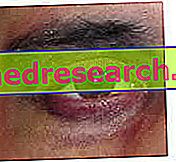Generality
"Black eye" is the expression used to describe an ecchymosis in the peri-orbital area, caused by a facial injury.

A black eye is a fairly common injury and, in most cases, represents a relatively minor injury that heals spontaneously after a few days. However, it can also result in more serious damage, which requires medical attention. For example, bleeding in the anterior ocular chamber (hyphema) can affect the cornea and produce consequences for vision.
Causes
- Despite what the name suggests, the black eye is not an eye injury but a bruise around the orbit.
- In most cases, a black eye is caused by a trauma to the face that causes rupture of the capillaries located around the eye socket and the resulting hematoma.
- Some treatments, such as plastic face surgery, can induce the development of a black eye, evident during post-operative recovery.
- Allergic reactions, hereditary conditions, skin or dental infections can cause swelling of the face. However, these do not cause the appearance of the typical dark color in the area around the eye.
Symptoms
After an injury that affects the eye area, it is important to distinguish between the symptoms of a "simple" black eye and those that could indicate a more severe head injury.
Symptoms of a black eye may include:
- Pain around the eye;
- Swelling around the eye. Edema can cause difficulty in opening the affected eye. In the following days, the swelling around the eyes should gradually decrease;
- The skin around the eyes may be reddened at first. Over time, the injured area progressively takes on a darker shade (red-bluish, then green, then yellow);
- Blurred vision and headache.
In the most serious cases, the appearance of a black eye can coincide with an ocular or cranial trauma and can be associated with the following manifestations: loss of vision, double vision, inability to move the eye, secretions of clear fluid or blood from the ears or from the nose, blood effusion on the anterior ocular surface, persistent headache or loss of consciousness. In some cases of trauma to the eye, increased pressure may occur within the eyeball (ocular hypertension). If both eyes are black, a skull fracture may have occurred.
Diagnosis
In most cases, all that is needed to diagnose a black eye is a physical exam. The doctor can check the movement of the eyes and the presence of abrasions or foreign bodies that can damage the eyeball. In addition, facial bones are examined to assess the extent of the wound.
Contusive injuries of the eyes, such as in some contact sports or ordinary accidents, could result in retinal detachment, internal bleeding or other problems. A fracture of the orbit could damage an ocular muscle, the surrounding soft tissues or the optic nerve. In some cases, surgery may be necessary to correct the condition.
To confirm the diagnosis, the patient can undergo an X-ray or a CT scan (computerized axial tomography). In the event of a more serious injury, the patient can be referred to an otolaryngologist, a neurosurgeon or a plastic surgeon in order to establish the most appropriate therapy.
When to consult a doctor
The patient should immediately consult a doctor if they develop severe pain and swelling unrelated to the injury, signs of infection, blood spill in the eye, behavioral or vision changes, nausea, dizziness or vomiting, or if the symptoms do not improve after few days of treatment.
Home Remedies
- For the first day, the application of an ice pack for 20 minutes, every hour, can help alleviate swelling and reduce internal bleeding due to cold-induced capillary constriction. The ice should not be placed directly in contact with the injured area, but some cubes should be wrapped in a cloth.
- The patient should protect the area from further injury until complete recovery. When possible, it is useful to rest to promote recovery.
- A stereotype involves placing a steak or other raw meat on the injured area, to facilitate healing of the black eye. This is not recommended, as there is a risk of bacterial contamination, which can cause more damage if the skin is damaged.
Medical treatment
In most cases, the doctor can prescribe analgesic drugs to help manage the pain and discomfort associated with the black eye. Furthermore, indications regarding the protection of the injured area can be provided.



